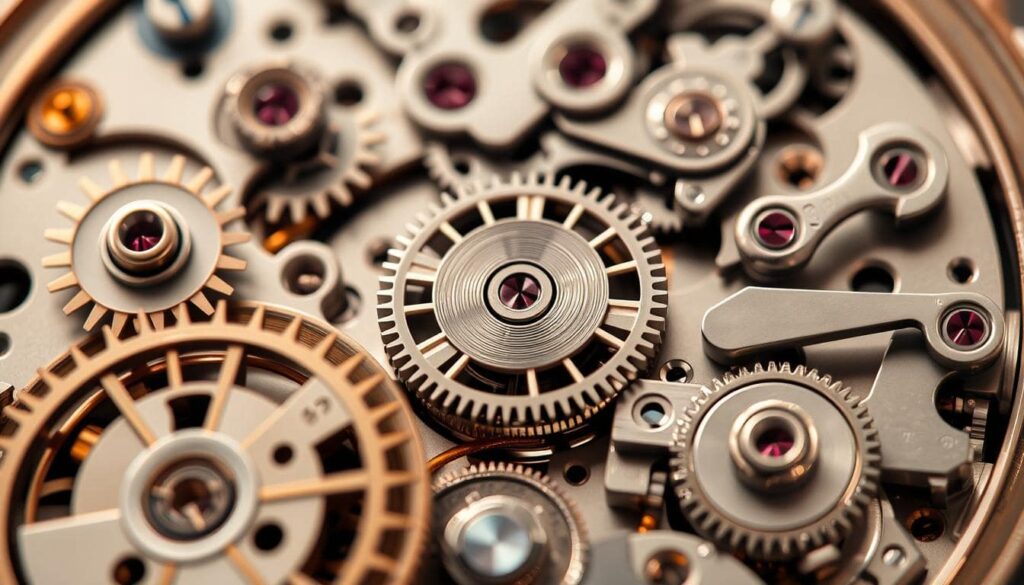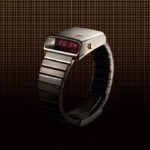Elevate Your Style with the Exquisite Beauty of Analog Wrist Watches
Analog wrist watches are making a strong comeback in today’s fashion world. More than just time-telling devices, these timeless accessories are now seen as powerful symbols of individuality, style, and tradition. According to Timex, “A watch is more than just telling time. It shows your style, taste, and individuality.”
This guide explores everything about analog wristwatches—their history, design, functionality, and their role as both fashion statements and collectibles.
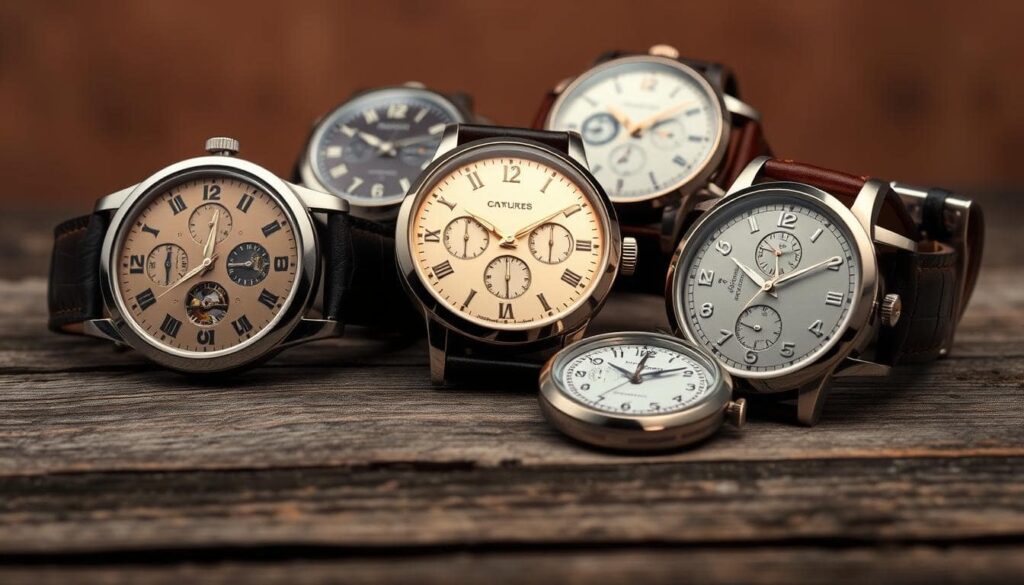
1. Why Analog Watches Are Still Relevant Today
Even in a digital world filled with smartwatches, analog wrist watches continue to win hearts for many reasons:
- Elegance and Simplicity: Brands like Armitron emphasize the easy-to-read dials and straightforward functionality of analog watches, which help users stay focused without tech distractions.
- Nostalgia and Tradition: Analog watches connect us to history and the craftsmanship of the past.
- Personal Style and Status: An analog watch is an accessory that complements outfits and reflects personal taste—offering both fashion and function.
2. What Makes an Analog Watch Unique
Analog watches display time using hands on a dial rather than a digital screen. Their main features include:
| Feature | Description |
|---|---|
| Dial | Face with numbers or markers |
| Hands | Hour, minute, and often second hands |
| Complications | Extra features like chronographs or date displays |
Analog watches are powered by either mechanical or quartz movements, each offering unique benefits.
3. Types of Analog Movements
Understanding movement types is essential for any watch enthusiast:
| Movement Type | Power Source | Accuracy | Maintenance |
|---|---|---|---|
| Mechanical | Hand-wound mainspring | Moderate | High |
| Automatic | Self-winding via wrist movement | Moderate | High |
| Quartz | Battery-powered with quartz crystal | High | Low |
- Mechanical: Revered for its craftsmanship; often collector’s items.
- Automatic: Convenient and self-winding, especially popular in Swiss watches.
- Quartz: Most accurate and low-maintenance; ideal for casual users.
- Mechanical
- A mechanical movement is a masterpiece of micro-engineering, a complex system of gears, springs, and levers that operates without any electronics or batteries. It is powered by a mainspring that is manually wound by the wearer, typically by turning the crown. The energy from the unwinding mainspring is released in precise, regulated increments through a series of gears known as the gear train. The distinctive “ticking” sound of a mechanical watch comes from the escapement, which acts as a brake, controlling the flow of energy to the balance wheel—the watch’s oscillating heart. Mechanical watches are a testament to traditional craftsmanship and are often considered living, wearable art. They are highly sought after by collectors for their historical significance and the visible artistry of their intricate components.
- Automatic
- An automatic, or “self-winding,” watch is a type of mechanical watch that offers the convenience of not requiring daily manual winding. It contains a half-moon-shaped rotor, a weighted mass that pivots freely on a central axis. As the wearer moves their wrist throughout the day, the rotor spins, automatically winding the mainspring. This ingenious system harnesses kinetic energy from the wearer’s daily activities to keep the watch powered. If left unworn for a period, the watch will eventually stop, but a simple shake or a few turns of the crown will start it again. Automatic watches are a popular choice among enthusiasts and casual wearers alike, as they blend the traditional craftsmanship and “soul” of a mechanical timepiece with a level of convenience that makes them suitable for daily wear.
- Quartz
- The quartz movement represents a dramatic departure from its mechanical predecessors, utilizing a battery and electronics to keep time. A small battery sends an electric current through a quartz crystal, causing it to vibrate at an incredibly precise frequency—typically 32,768 times per second. An integrated circuit then counts these vibrations and sends an electrical pulse once every second to a small motor, which advances the watch’s hands. Because the vibrations of a quartz crystal are so stable, these watches are significantly more accurate than their mechanical counterparts, often losing or gaining only a few seconds a month. Quartz watches are known for their affordability, durability, and low maintenance, requiring little more than a battery change every few years. They are the most popular type of watch movement in the world today, valued for their reliability and practicality.
4. History and Evolution of Analog Wrist Watches
Analog watches have a rich timeline that starts with pocket watches and evolves into sleek wrist designs:
- WWI Impact: Soldiers favored wristwatches over pocket ones for practicality, shifting public preference.
- Innovation Over Time: The development of automatic and quartz technologies improved precision and style.
Today, analog watches blend vintage charm with modern aesthetics, appealing to collectors and style-conscious individuals alike.
5. Craftsmanship: Components and Watchmaking Art
Analog wristwatches are engineering marvels that represent a blend of art and science. Key components include:
- Movement (Caliber): The engine of the watch.
- Mainspring: Powers the mechanical movement.
- Gears and Balance Wheel: Regulate time.
- Dial Train: Transfers energy to the hands.
- Case, Strap, and Crystal: Complete the physical form.
The art of watchmaking involves precision, attention to detail, and expert craftsmanship—especially in luxury or heritage pieces.
A mechanical watch, at its core, is a remarkable feat of miniaturized engineering, with each component playing a crucial role in its function and form. The following elements represent the fundamental building blocks of an analog watch, from the internal mechanisms that keep time to the external parts that define its aesthetic and protect its delicate inner workings.
Movement (Caliber): The Engine of the Watch Referred to by watchmakers as the “calibre,” the movement is the intricate heart of a watch. It is a self-contained mechanism that powers all of the watch’s functions, from the basic movement of the hands to any additional complications like a date display or chronograph. The movement is the most important indicator of a watch’s quality and value, as it showcases the horologist’s skill and craftsmanship. It is the complex system of interconnected parts that takes energy from the power source and translates it into the precise, regulated motion that allows a watch to accurately measure the passage of time.
Mainspring: The Power Source The mainspring is the engine’s fuel tank, a long, coiled ribbon of metal that stores the potential energy needed to power a mechanical watch. When a watch is wound, either manually by the wearer or automatically by a rotor, the mainspring is coiled tighter, storing energy. As the watch runs, this energy is released in a controlled manner as the mainspring slowly unwinds. This gradual release of power is what drives the watch’s various components. In automatic watches, the mainspring has a special “sliding bridle” at its end that allows it to slip when fully wound, preventing damage from overwinding.
Gears and Balance Wheel: Regulating Time The energy released by the mainspring must be carefully regulated to keep accurate time. This is the job of the gear train and the balance wheel. The gear train, a series of precisely meshed wheels and pinions, transfers the power from the mainspring throughout the movement. However, without a regulating organ, the mainspring’s energy would simply dissipate in a matter of seconds
Dial Train: Transferring Energy to the Hands The dial train is a small, specialized series of gears located on the front of the movement, just under the watch’s face. Its sole purpose is to transfer the regulated energy from the balance wheel and the rest of the movement to the watch’s hands. It is responsible for ensuring that the hour, minute, and second hands move at the correct, coordinated speeds relative to each other. For example, the dial train’s gears are set up in a ratio that allows the hour hand to move once for every 12 rotations of the minute hand, making sure the time is displayed accurately on the dial.
Case, Strap, and Crystal: The Physical Form While the movement is the core of the watch, the case, strap, and crystal define its physical form, protect its delicate parts, and establish its aesthetic. The case, typically made from materials like stainless steel, titanium, or precious metals, houses the movement and provides protection from dust, moisture, and shock.y.
6. Benefits of Wearing Analog Watches
a. Style and Fashion Accessory
Analog watches elevate your appearance. They’re suitable for both formal and casual occasions and act as style signatures. As Timex says, their watches are “versatile enough to keep pace with your life.”
b. Durability and Heirloom Potential
With proper care, analog watches can last for decades, making them potential family heirlooms.
c. No Tech Dependency
Mechanical and automatic watches don’t rely on electricity or software, making them incredibly reliable—especially during travel or power outages.
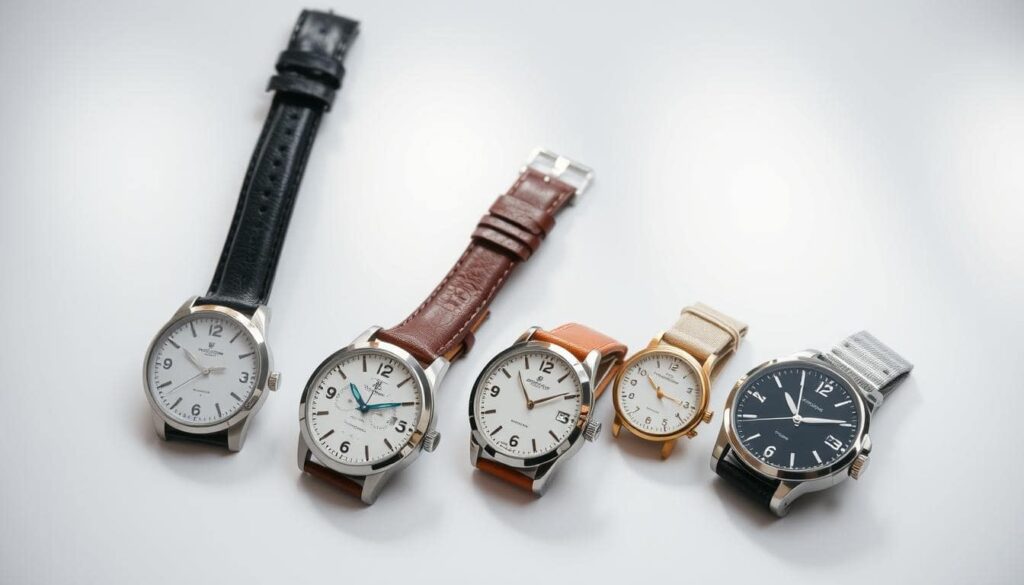
7. Different Styles of Analog Watches
There’s an analog watch style for every personality and occasion:
| Watch Style | Key Features | Best For |
|---|---|---|
| Dress | Slim, minimal, leather strap | Formal events |
| Dive | Water-resistant, luminous dials, rotating bezel | Underwater and sports use |
| Pilot | Large, legible dials with chronographs | Aviation-inspired fashion |
| Field | Military look, rugged, reliable | Outdoor or tactical style |
| Chronograph | Stopwatch functionality | Sports, technical fashion |
8. Vintage Analog Watches: A Collector’s Dream
Vintage analog watches carry stories, history, and high craftsmanship. Many collectors treasure these timepieces for their beauty and uniqueness.
Iconic Vintage Models
- Rolex Submariner: Symbol of toughness and prestige.
- Omega Speedmaster: Known for its role in space missions.
Vintage watches often appreciate in value, making them attractive as both collectibles and investments.
Tips for Starting a Collection
- Research brand history and model rarity.
- Purchase from reputable dealers.
- Consider condition, originality, and movement type.
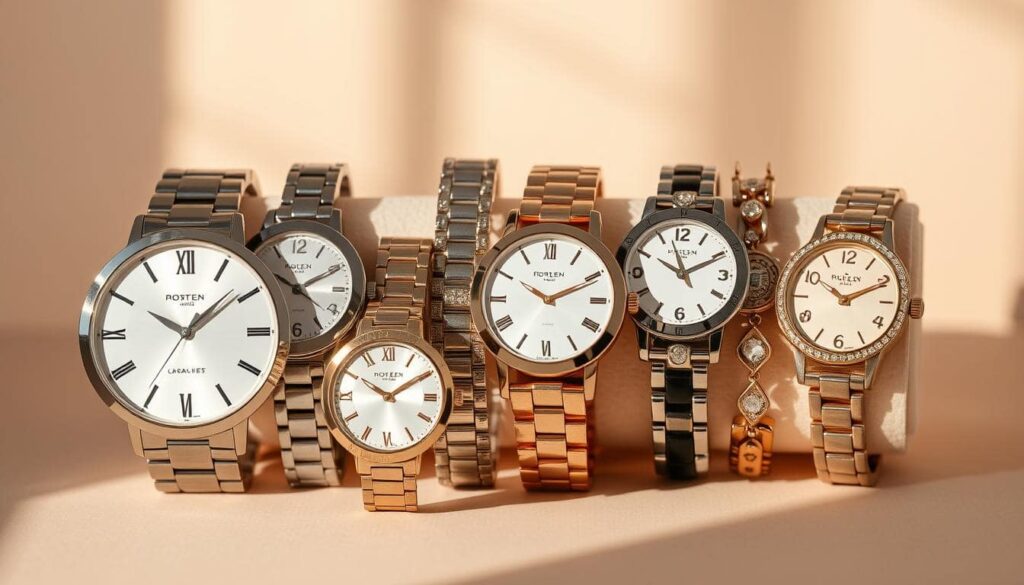
9. Men’s Analog Watches: Classic to Modern Trends
Men’s analog watches range from timeless classics to contemporary designs:
Classic Styles
- Leather straps and clean dials
- Perfect for formal settings like work or business meetings
Contemporary Styles
- Bolder designs, metal bands, colorful dials
- Ideal for casual wear and self-expression
Whatever the style, an analog watch can elevate a man’s appearance and confidence.
10. Women’s Analog Watches: Beauty Meets Function
Women’s analog watches are not only elegant but also practical. They come in both subtle and statement-making designs.
Fashion-Forward Designs
- Crystal embellishments, thin profiles
- Match perfectly with stylish outfits
Jewelry-Inspired Timepieces
- Blend watch function with bracelet beauty
- Great for social events or daily wear
With options ranging from minimalistic to ornate, there’s a watch for every woman’s style.
11. How to Choose the Perfect Analog Watch for You
Here are key considerations when picking the right watch:
Match with Wardrobe
- Formal wear: leather strap or thin, elegant design
- Casual wear: stainless steel or bold colors
Watch Size and Proportion
- Ensure the case size matches your wrist size.
- Avoid overly bulky or too small watches for balance and comfort.
Budget: Luxury vs. Affordable
| Watch Type | Features | Ideal For |
|---|---|---|
| Luxury | High-end materials, fine craftsmanship | Long-term investment, collectors |
| Affordable | Stylish and functional without high cost | Budget-conscious buyers |
Luxury watches offer heritage and exclusivity, while affordable watches provide everyday usability without compromise on style.
The chasm between luxury and affordable watches is defined by more than just a price tag; it’s a difference in philosophy, craftsmanship, and the very purpose of the timepiece itself. While both can tell time with a high degree of accuracy, the features and the overall experience they offer are fundamentally distinct.
Luxury Watches: An Investment in Art and Craftsmanship
Luxury watches are not merely accessories; they are works of art, a culmination of centuries of horological heritage and meticulous craftsmanship. The high cost is a direct reflection of the materials, the expertise required for their creation, and the brand’s legacy.
- High-End Materials: Luxury watches are crafted from the finest materials. Cases are typically made from precious metals like solid gold, platinum, or high-grade stainless steel like 904L, which is more resistant to corrosion than the standard grades. The glass is almost always scratch-resistant sapphire crystal. Every detail, from the hands and indices on the dial to the screws in the movement, is made with an uncompromising focus on quality.
- Fine Craftsmanship: The true value of a luxury watch lies in the human artistry behind it. Many luxury watches feature a mechanical or automatic movement that is hand-assembled by a master watchmaker. The intricate parts are not just functional but also exquisitely decorated with techniques like Côtes de Genève (Geneva stripes), perlage (circular graining), and hand-finished beveled edges. This meticulous attention to detail makes each watch unique and demonstrates a level of skill that cannot be replicated by mass production.
- Ideal for Long-Term Investment and Collectors: Due to their timeless design, superior build quality, and limited production, many luxury watches retain or even appreciate in value over time. Brands like Rolex, Patek Philippe, and Audemars Piguet have models that are considered a solid financial investment, often fetching high prices in the secondary market. For collectors, owning a luxury watch is about preserving a piece of horological history and a legacy of fine craftsmanship.
Affordable Watches: Stylish, Functional, and Accessible
Affordable watches, on the other hand, prioritize style, functionality, and accessibility without the high cost of luxury. They are designed for the everyday wearer who wants a reliable timepiece that complements their style without being a significant financial commitment.
- Stylish and Functional without High Cost: Affordable watches, often powered by highly accurate and low-maintenance quartz movements, are celebrated for their practicality. Brands like Casio, Seiko, and Citizen have built their reputations on offering durable, stylish, and feature-rich watches at a price point that is accessible to a broad audience. For instance, a watch might use a mineral glass crystal instead of sapphire and a less expensive stainless steel or plastic case. While these materials are not as luxurious, they are more than sufficient for daily wear.
- Ideal for Budget-Conscious Buyers: Affordable watches are perfect for those who want a quality timepiece for a specific occasion, a fashionable accessory to match an outfit, or a reliable watch for daily use without the worry of damage or loss. They offer a vast array of styles, from rugged digital G-Shocks to elegant dress watches like the Seiko Presage, allowing buyers to find a watch that fits their personality and needs. The rise of brands that offer “micro-brand” mechanical watches has also made the traditional watchmaking experience more attainable for those on a budget.
In essence, the choice between luxury and affordable watches is a personal one that reflects a buyer’s values. A luxury watch is a passion purchase, an investment in a piece of art that tells a story of heritage and craftsmanship. An affordable watch is a practical and stylish choice, a testament to the fact that you don’t need to spend a fortune to have a well-designed and reliable timepiece on your wrist.
12. Conclusion: The Enduring Charm of Analog Watches
Analog wristwatches are more than timepieces—they’re reflections of identity, tradition, and artistry. Whether mechanical, automatic, or quartz, each watch type brings something special to the table.
They appeal to everyone: from professionals who want understated elegance, to adventurers needing rugged functionality, to collectors seeking history and beauty.
Despite technological advancements in smartwatches, analog watches stand strong because they represent something eternal—a celebration of craftsmanship, culture, and personal expression.
Table of Contents
FAQ Recap
Q: What is an analog wristwatch?
A: A watch that shows time using hour and minute hands on a dial.
Q: What are the benefits of analog watches?
A: They’re stylish, long-lasting, tech-independent, and often collectible.
Q: What are the different movement types?
A: Mechanical (hand-wound), automatic (self-winding), and quartz (battery-powered).
Q: How do I choose the right analog watch?
A: Consider your wardrobe, wrist size, budget, and preferred style.
Q: What are vintage timepieces?
A: Classic analog watches with historical and collectible value.
Q: What makes men’s and women’s analog watches different?
A: Men’s watches lean toward size and function; women’s watches emphasize elegance and design.
Q: How do mechanical watches work?
A: They run using a hand-wound mainspring and intricate internal mechanics.
Q: Difference between automatic and quartz?
A: Automatic watches wind through motion; quartz watches use battery power and are more accurate.

